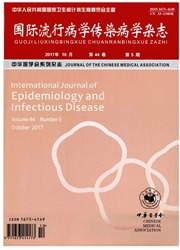

 中文摘要:
中文摘要:
目的制备针对流感病毒基质蛋白M1的单克隆抗体(mAb),为研究流感病毒检测试剂盒提供实验材料。方法以纯化的M1蛋白为免疫原,免疫Balb/c小鼠,将其脾细胞与骨髓瘤细胞(SP2/0)融合,筛选出分泌抗M1 mAb的杂交瘤细胞,注射小鼠腹腔获得M1mAb,并用辣根过氧化物酶(HRP)标记M1mAb。通过Western印迹法、EUSA、细胞感染免疫染色实验检测所获M1mAb的作用和特性。结果获得能稳定分泌抗流感病毒基质蛋白M1的杂交瘤细胞系,纯化腹水得到M1mAb和HRP—M1mAb。Western印迹法结果显示,M1mAb和HRP—M1mAb能与M1抗原及H1N1、H3N2亚型流感病毒的M1蛋白反应,是针对M1蛋白的mAb;利用ELISA方法研究M1mAb和HRP.M1mAb对M1抗原及流感病毒的检测作用,结果显示它们能检测H1N1和H3N2亚型的甲型流感病毒,而HRP.M1mAb的检测能力比M1mAb强;细胞免疫染色实验显示,M1mAb能结合H1N1和H3N2亚型病毒感染的细胞。结论针对M1蛋白的M1mAb和HRP—M1mAb已制备成功。它们能检测H1N1和H3N2亚型甲型流感病毒,有望应用于流感病毒诊断以及鉴别诊断试剂盒的研发。
 英文摘要:
英文摘要:
Objective To obtain matrix protein M1 monoclonal antibody (mAb), and provide experimental material for influenza virus detection kits. Methods The Balb/c mice were immunized with the purified M1 protein, and their spleen cells were fused with mouse myeloma cells (SP2/0). The hybridoma cells that secreting against M1 mAb were screened by enzyme-linked immunosorbent assay (ELISA). M1 mAbs were obtained by intraperitoneal inoculation of mice and conjugated by horseradish peroxidase (HRP). The function and characteristics of M1 mAb and HRP-M1 mAb were detected by Western blotting, ELISA, cell-mediated immunity experiments. Results The hybridoma cells were obtained which could steadily secret anti-influenza virus matrix protein M1 mAb. M1 mAb and HPR-M1 mAb were obtained from purified ascitie fluid. Western blotting showed that the obtained M1 mAb and HRP-M1 mAb could react with M1 protein and H1N1, H3N2 subtypes of influenza virus, indicating that they were mAb antibodies against the M1 protein. By using ELISA, the sensitivity of M1 mAb and HRP-M1 mAb detecting M1 antigen and influenza viruses were studied, and the results demonstrated that both of them could detect H1N1 and H3N2 subtypes of influenza A virus. In addition, the ability of HRP-M1 mAb to detect virus was higher than M1 mAb. The cell injected immune result showed that the M1 mAb could combine with the cells infected with H1N1 and H3N2 influenza virus. Conclusions The M1 mAb and HRP-M1 mAb that against M1 protein can be prepared. The antibodies can detect H1N1 and H3N2 subtypes of influenza A virus, while M1 protein and antibody can be applied to the research and development of the diagnosis and detect kit for influenza A virus.
 同期刊论文项目
同期刊论文项目
 同项目期刊论文
同项目期刊论文
 期刊信息
期刊信息
